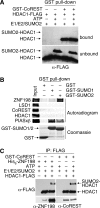ZNF198 stabilizes the LSD1-CoREST-HDAC1 complex on chromatin through its MYM-type zinc fingers
- PMID: 18806873
- PMCID: PMC2532748
- DOI: 10.1371/journal.pone.0003255
ZNF198 stabilizes the LSD1-CoREST-HDAC1 complex on chromatin through its MYM-type zinc fingers
Abstract
Histone modifications in chromatin regulate gene expression. A transcriptional co-repressor complex containing LSD1-CoREST-HDAC1 (termed LCH hereafter for simplicity) represses transcription by coordinately removing histone modifications associated with transcriptional activation. RE1-silencing transcription factor (REST) recruits LCH to the promoters of neuron-specific genes, thereby silencing their transcription in non-neuronal tissues. ZNF198 is a member of a family of MYM-type zinc finger proteins that associate with LCH. Here, we show that ZNF198-like proteins are required for the repression of E-cadherin (a gene known to be repressed by LSD1), but not REST-responsive genes. ZNF198 binds preferentially to the intact LCH ternary complex, but not its individual subunits. ZNF198- and REST-binding to the LCH complex are mutually exclusive. ZNF198 associates with chromatin independently of LCH. Furthermore, modification of HDAC1 by small ubiquitin-like modifier (SUMO) in vitro weakens its interaction with CoREST whereas sumoylation of HDAC1 stimulates its binding to ZNF198. Finally, we mapped the LCH- and HDAC1-SUMO-binding domains of ZNF198 to tandem repeats of MYM-type zinc fingers. Therefore, our results suggest that ZNF198, through its multiple protein-protein interaction interfaces, helps to maintain the intact LCH complex on specific, non-REST-responsive promoters and may also prevent SUMO-dependent dissociation of HDAC1.
Conflict of interest statement
Figures








Similar articles
-
Direct binding of CoREST1 to SUMO-2/3 contributes to gene-specific repression by the LSD1/CoREST1/HDAC complex.Mol Cell. 2009 Apr 24;34(2):145-54. doi: 10.1016/j.molcel.2009.03.013. Mol Cell. 2009. PMID: 19394292 Free PMC article.
-
An essential role for CoREST in nucleosomal histone 3 lysine 4 demethylation.Nature. 2005 Sep 15;437(7057):432-5. doi: 10.1038/nature04021. Epub 2005 Aug 3. Nature. 2005. PMID: 16079794
-
Engagement of the lysine-specific demethylase/HDAC1/CoREST/REST complex by herpes simplex virus 1.J Virol. 2009 May;83(9):4376-85. doi: 10.1128/JVI.02515-08. Epub 2009 Feb 4. J Virol. 2009. PMID: 19193804 Free PMC article.
-
CoREST-like complexes regulate chromatin modification and neuronal gene expression.J Mol Neurosci. 2006;29(3):227-39. doi: 10.1385/JMN:29:3:227. J Mol Neurosci. 2006. PMID: 17085781 Review.
-
Modulation of thyroid hormone receptor silencing function by co-repressors and a synergizing transcription factor.Biochem Soc Trans. 2000;28(4):386-9. Biochem Soc Trans. 2000. PMID: 10961925 Review.
Cited by
-
Avadomide induces degradation of ZMYM2 fusion oncoproteins in hematologic malignancies.Blood Cancer Discov. 2021 May;2(3):250-265. doi: 10.1158/2643-3230.BCD-20-0105. Epub 2021 Mar 10. Blood Cancer Discov. 2021. PMID: 34027417 Free PMC article.
-
Identification and characterization of BEND2 as a key regulator of meiosis during mouse spermatogenesis.Sci Adv. 2022 May 27;8(21):eabn1606. doi: 10.1126/sciadv.abn1606. Epub 2022 May 25. Sci Adv. 2022. PMID: 35613276 Free PMC article.
-
Identifying regulators of parental imprinting by CRISPR/Cas9 screening in haploid human embryonic stem cells.Nat Commun. 2021 Nov 18;12(1):6718. doi: 10.1038/s41467-021-26949-7. Nat Commun. 2021. PMID: 34795250 Free PMC article.
-
Distinct roles of cohesin-SA1 and cohesin-SA2 in 3D chromosome organization.Nat Struct Mol Biol. 2018 Jun;25(6):496-504. doi: 10.1038/s41594-018-0070-4. Epub 2018 Jun 4. Nat Struct Mol Biol. 2018. PMID: 29867216 Free PMC article.
-
PLK1 and HOTAIR Accelerate Proteasomal Degradation of SUZ12 and ZNF198 during Hepatitis B Virus-Induced Liver Carcinogenesis.Cancer Res. 2015 Jun 1;75(11):2363-74. doi: 10.1158/0008-5472.CAN-14-2928. Epub 2015 Apr 8. Cancer Res. 2015. PMID: 25855382 Free PMC article.
References
-
- Luger K. Structure and dynamic behavior of nucleosomes. Curr Opin Genet Dev. 2003;13:127–135. - PubMed
-
- Davey CA, Sargent DF, Luger K, Maeder AW, Richmond TJ. Solvent mediated interactions in the structure of the nucleosome core particle at 1.9 Å resolution. J Mol Biol. 2002;319:1097–1113. - PubMed
-
- Luger K, Mader AW, Richmond RK, Sargent DF, Richmond TJ. Crystal structure of the nucleosome core particle at 2.8 Å resolution. Nature. 1997;389:251–260. - PubMed
-
- Luger K, Hansen JC. Nucleosome and chromatin fiber dynamics. Curr Opin Struct Biol. 2005;15:188–196. - PubMed
-
- Jenuwein T, Allis CD. Translating the histone code. Science. 2001;293:1074–1080. - PubMed
Publication types
MeSH terms
Substances
Grants and funding
LinkOut - more resources
Full Text Sources
Other Literature Sources
Medical
Miscellaneous

